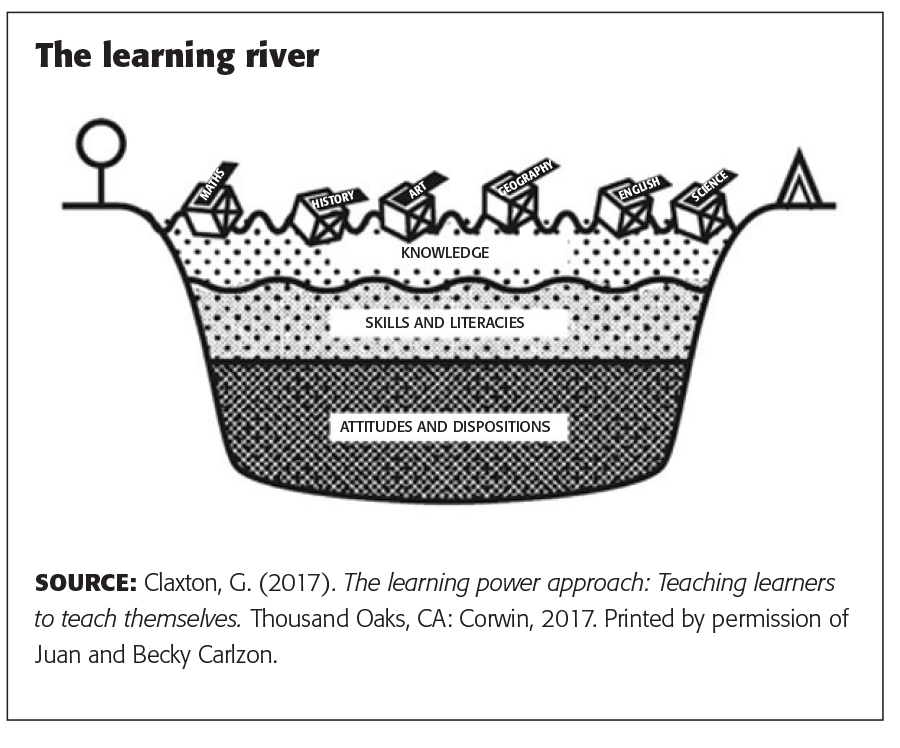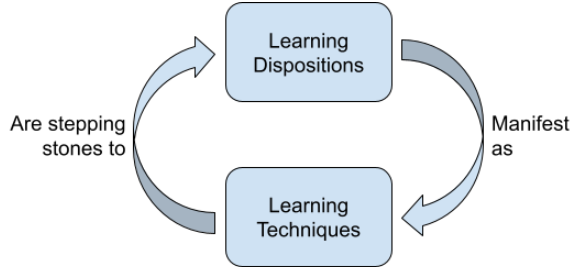Educators from all sides of the spectrum seem to agree that it isn’t sufficient for us to support students to just develop academic knowledge, we also need to support them to develop characteristics that will help them to have, ‘Healthy relationships to themselves, to other people, and to learning so that they can navigate their lives in ways that are empowering and satisfying to them.’ – Kate McAllister)
This idea is captured well by Guy Claxton’s idea of the learning river.

The learning river is a powerful metaphor that describes three different layers of learning that simultaneously occur in the vast majority of classrooms (whether we, as teachers, have designed it or not!). On the surface, and most readily observable, we teach knowledge. Deeper down we teach skills and literacies that support that knowledge. And flowing along the bottom, often imperceptibly, is the formation of attitudes and dispositions.
And herein lies the challenge. The formation of dispositions is often unconscious, unintended, and difficult to perceive.
Whilst I’ve believed in the importance of developing dispositions in students for a long time, it’s only recently that I feel I’ve gained a little clarity around how this can actually be done through the development of some new ideas in relation to these two constructs. It is these ideas that I share in the following.
Techniques and Dispositions: Searching for clarity
One thing that I try to do whenever I’m trying to gain clarity around something, whether for myself or for my students, is to construct a ‘bullet proof’ definition. This idea, originally from Explicit Direct Instruction, forces me to boil my thinking down into a single concise sentence. Here’s what I’ve come up with for dispositions, techniques, and their combination, which I see as the ability to learn how to learn.
Bullet proof definitions
Learning dispositions refer to cognitive and emotional habits that an individual has formed in relation to learning (e.g., curiosity, resilience, etc)
Learning techniques are the actions that students take during, in preparation for, or following, learning (e.g., note taking, retrieval practice, meditation, learning journals, (lots more examples here).
Learning to learn is the process of acquiring the learning techniques and dispositions that empower an individual to be a more successful learner.
Dispositions in more depth
Just as we develop habits in other areas of our life, so we develop habits in relation to our learning. These habits can be healthy and empowering, forming a strong basis for further growth and progress. Or they can be unhealthy and constraining, curtailing our long-term learning and wellbeing.
Learning dispositions can be thought of as the habits that we find ourselves enacting in different learning environments. They are the conditioned, instinctual, and automatic ways in which we respond to learning opportunities and challenges. Do we give up or persevere when we get stuck on a problem? Do instinctually engage in centring exercises when faced with a challenge (example at the start of this podcast) or do we work ourselves into a flurry through negative self-talk?
An example of a productive learning disposition is reflection. A reflective learner will habitually stop part way through a task, or once they’re finished, and reconsider what the task was, how they responded to it, and what they could do differently next time. Another example of a productive learning disposition is curiosity. A curious learner will continue to ask ‘why’ questions, guiding them towards a greater depth of understanding.
This is all very well and good, but how on earth do we teach these dispositions? I’ve felt very lost on this front for a long time. Moreover, I’ve seen (and participated myself) in a lot of ineffective attempts at this. If we take the example of growth mindset, a great example is what Tom Sherrington has referred to as Growth Mindset Cheese. We put up posters, we give assemblies on these things, but we don’t actually do anything that materially supports our students to develop these desirable dispositions.
From Techniques to Dispositions, and back again
The clarity I’ve gained recently is in relation to the distinction between learning techniques and dispositions, and how each supports and reinforces the other, a relationship that can be utilised to effectively support the development of each. These ideas are tentative and developing, but they’re beginning to settle into a structure that has helped me to feel better prepared to effectively support the development of dispositions within my students.
Idea 1: Learning techniques are the stepping stones to dispositions

Habits of any kind can’t be taught directly. What can be taught are techniques, and a technique utilised with diligence and over time can lead to habit formation. If we want to develop the habit of daily exercise, we may utilise the techniques of laying out our exercise clothing the night before, setting an alarm to go off each day as a reminder, or roping a friend into the activity as well. These are all actions that can be taken that can encourage daily exercise to become a habit.
To return to our learning dispositions, a students could be taught some techniques for reflection, such as how to make an entry in a learning journal each week, how to conduct a plenary discussion with their classmates, or even how to meditate and make space for reflective insights to arise. Over time, these techniques could lead to the student becoming a more reflective person, a person who has developed a reflective disposition. This is the way in which learning techniques are the stepping stones to dispositions.
Idea 2: Learning techniques are manifestations of dispositions
Dispositions can’t be observed directly, so we rely upon observations of the techniques that students are using to infer their learning dispositions. If a student begins to spontaneously use a learning technique without prompting, but in a familiar environment, this is evidence that a disposition is beginning to form. If a technique is applied to a new domain, or a student comes up with their own technique, this is evidence that the disposition is becoming secure, flexible, and transferable.
…
These ideas are developing, and are informed What by the work of Guy Claxton, James Mannion, Kate McAllister, Art Costa, John Hattie, Jay McTighe, and others, I’d love to hear from you if you have any thoughts, critiques, reflections, or suggestions in relation to this post!
Summary
- The Big Idea: Learning to Learn means preparing students to motor on alone after we stop pushing (at the end of school, or even earlier)
- Learning to learn is the process of acquiring the learning techniques and dispositions that empower an individual to be a more successful learner.
- Learning dispositions refer to cognitive and emotional habits that an individual has formed in relation to learning (e.g., curiosity, resilience, etc)
- Learning techniques are the actions that students take during, in preparation for, or following, learning (e.g., note taking, retrieval practice, meditation, learning journals)
- The relationship between dispositions and techniques: Learning dispositions are the both stepping stones to dispositions, and ways in which dispositions reveal themselves in observable ways.